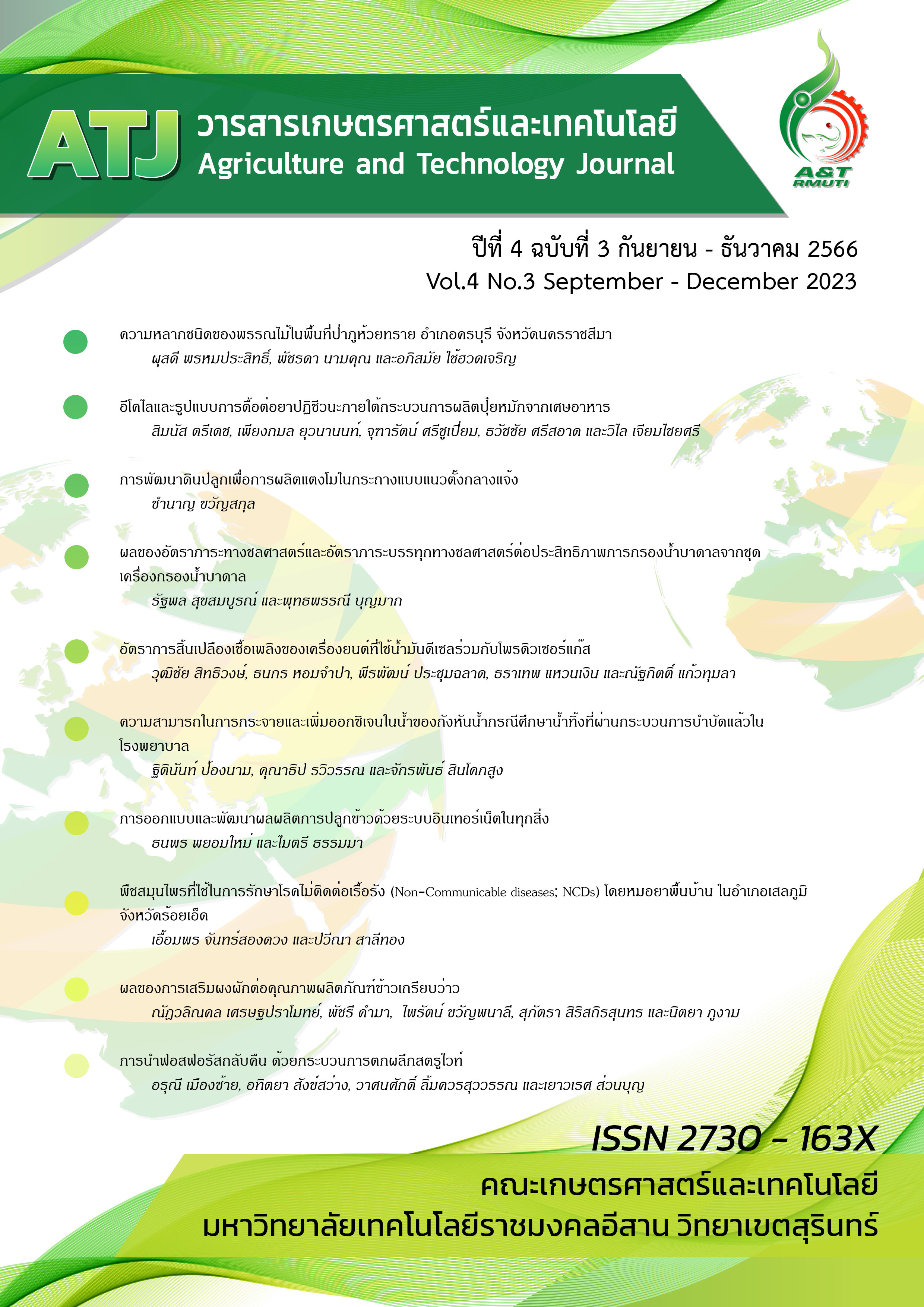Fate of Escherichia coli and their antibiotic resistant pattern in food waste composting process
Keywords:
Organic fertilizer, Composting process, Food waste, Antibiotic resistant bacteriaAbstract
This study was investigated a potential pathogenic bacteria and antibiotic resistant bacteria (ARB) from the food waste composting. Moreover, study on environment factors may effect to pathogenic bacteria and ARB persistence under food waste composting. Escherichia coli as a representative bacterial in this study. Investigated compost for 8 weeks in 150 L reactors in aerobic condition. The results of ARB from materials before composting indicated multiple antibiotic resistant (MAR) index of E. coli was 0.312. First phase of composting, temperature inside composts were increased to 37.0-57.0 OC. E. coli survival under high temperature condition had developed to high level of antibiotic resistant and decreased to low level depended on time period. The results of ARB development in 8 weeks of composting was decreased, MAR index of E. coli was 0.214. Most of E. coli survival classified as ARB which resisted to 1 antibiotic group (60%). Moreover, MAR index of E. coli (0.405) from leachate of food waste composting was higher than in compost and decreased depended on ferment time period (7th week, MAR index = 0.150). Therefore, using of food waste compost should be needed more time for completely composting or prolonged compost using to reduced ARB contamination. To reduce the high level of ARB may contaminate in compost, there should be an appropriate leachate management system for protecting the widespread of ARB to the environment.
References
กรมวิชาการเกษตร. (2564). หลักเกณฑ์การพิจารณาปัจจัยการผลิตพืชอินทรีย์ที่ขอขึ้นทะเบียนเพื่อการค้า (ฉบับปรับปรุง ณ วันที่ 7 มกราคม 2564). ค้นเมื่อ 25 กรกฎาคม 2566. https://www.doa.go.th/psco/wp-content/uploads/ 2020/06/Organic_1.pdf.
AOAC. (2000). Official Methods of Analysis of AOAC International. 17th Edition. Maryland, USA.
APHA, AWWA, WEF. (2012). Standard method for the examination of water and wastewater. 22nd Edition. Washington, DC, USA.
Chen Z., Li Y., Ye C., He X. and Zhang S. (2021). Fate of antibiotics and antibiotic resistance genes during aerobic co-composting of food waste with sewage sludge. Science of the Total Environment. 784: 146950. doi:10.1016/j.scitotenv.2021.146950.
CLSI. (2012). Performance standards for antimicrobial susceptibility testing; twenty-second in formational supplement. Clinical and Laboratory Standards Insititute.
Collins C.H., Lyne P. M., Grange J. M. and Falkinham III J. O. (2004). Microbiological Methods. 8th Edition. Oxford University Press Inc. London.
Furukawa M., Misawa N. and Moore J.E. (2018). Recycling of domestic food waste does food waste composting carry risk from total antimicrobial resistance (AMR). British Food Journal. 120(11): 2710-2715.
Gou M., Hu H.W., Zhang Y.J., Wang J.T., Hayden H., Tang Y.Q. and He J.Z. (2018). Aerobic composting reduces antibiotic resistance genes in cattle manure and the resistome dissemination in agriculture soils. Science of the Total Environment. 612: 1300-1310.
Guo W., Huang C., Xi B., Tang Z., Tan W., Li W., Zhang Y. and Li W. (2021). The maturity period is the main stage of antibiotic resistance genes reduction in aerobic composting process of swine manure in sub-scale farms. Bioresource Technology. 319: 124139. doi:10.1016/j.biortech.2020.124139.
Kebibeche H., Khelil O., Kacem M. and Harche M.K. (2019). Addition of wood sawdust during the co-composting of sewage sludge and wheat straw influences seeds germination. Ecotoxicology and Environmental Safety. 168: 423-430.
Kelly B.G., Vespermann A. and Bolton D.J. (2009). Horizontal gene transfer of virulence determinants in selected bacterial foodborne pathogens. Food and Chemical Toxicology. 47: 969-977.
Li H., Zheng X., Cao H., Tan L., Yang B., Cheng W. and Xu Y. (2021). Reduction of antibiotic resistance genes under different conditions during composting process of aerobic combined with anaerobic. Bioresource Technology. 325: 124710. doi:10.1016/j.biortech.2021.124710.
Mesa R.J., Blanc V., Blanch A.R., Cortés P., Genzález J.J., Lavilla S., Miró E., Muniesa M., Saco M., Tórtola M.T., Mirelis B., Coll P., Llagostera M., Prats G. and Navarro F. (2006). Extended-spectrum -lactamase-producing Enterobacteriaceae in different environments (humans, food, animal farms and sewage). Journal of Antimicrobial Chemotherapy. 58: 211-215.
Palaniveloo K., Amran M.A., Norhashim N.A., Mohamad-Fauzi N., Peng-Hui F., Hui-Wen L., Kai-Lin Y., Jiale L., Chian-Yee M.G., Jing-Yi L., Gunasekaran B. and Razak S.A. (2020). Food Waste Composting and Microbial Community Structure Profiling. Processes. 8: 723. doi:10.3390/pr8060723.
Qiu X., Zhou G., Chen L. and Wang H. (2021). Additive quality influences the reservoir of antibiotic resistance genes during chicken manure composting. Ecotoxicology and Environmental Safety. 220: 112413. doi:10.1016/j.ecoenv.2021.112413.
Rupp M.E. and Fey P.D. (2003). Extended spectrum -lactamase (ESBL)-producing Enterobacteriaceae considerations for diagnosis, prevention and drug treatment. Drugs. 63(4): 353-365.
Wang N., Yang X., Jiao S., Zhang J., Ye B. and Gao S. (2014). Sulfonamide-resistant bacteria and their resistance genes in soil fertilized with manures from Jiangsu province, southeastern China. PLOS ONE. 9(11): 1-11.
Wang P., Chen X., Liang X., Cheng M. and Ren L. (2019). Effects of nanoscale zero-valent iron on the performance and the fate of antibiotic resistance genes during thermophilic and mesophilic anaerobic digestion of food waste. Bioresource Technology. 293: 122092. doi:10.1016/j.biortech.2019.122092.
Wellington E.M.H, Boxall A.B.A., Cross P., Feil E.J., Gaze W.H., Hawkey P.M., Johnson-Rollings A.S., Jones D.L., Lee N.M., Otten W., Thomas C.M. and Williams A.P. (2013). The role of the natural environment in the emergence of antibiotic resistance in Gram-negative bacteria. Lancet Infection Disease. 13: 155-165.
Zhang Y.J., Hu H.W., Yan H., Wang J.T., Lam S.K., Chen Q.L., Chen D. and He J.Z. (2019). Salinity as a predominant factor modulating the distribution patterns of antibiotic resistance genes in ocean and river beach soils. Science of The Total Environment. 668: 193-203.
Zhao Y., Chen W., Zhang P., Cai J., Lou Y. and Hu B. (2022). Microbial cooperation promotes humification to reduce antibiotic resistance genes abundance in food waste composting. Bioresource Technology. 362: 127824. doi:10.1016/j.biortech.2022.127824.
Downloads
Published
Versions
- 2024-02-19 (2)
- 2023-12-29 (1)
How to Cite
Issue
Section
License
Copyright (c) 2023 Agriculture and Technology Journal

This work is licensed under a Creative Commons Attribution-NonCommercial-NoDerivatives 4.0 International License.
เนื้อหาและข้อมูลในบทความที่ลงตีพิมพ์ในวารสารทดสอบระบบ ThaiJo2 ถือเป็นข้อคิดเห็นและความรับผิดชอบของผู้เขียนบทความโดยตรงซึ่งกองบรรณาธิการวารสาร ไม่จำเป็นต้องเห็นด้วย หรือร่วมรับผิดชอบใดๆ
บทความ ข้อมูล เนื่อหา รูปภาพ ฯลฯ ที่ได้รับการดีพิมพ์ในวารสารทดสอบระบบ ThaiJo2 ถือเป็นลิขสิทธิ์ของวารสารทดสอบระบบ ThaiJo2 หากบุคคลหรือหน่วยงานใดต้องการนำทั้งหมดหรือส่วนหนึ่งส่วนใดไปเผยแพร่หรือเพื่อกระทำการใดๆ จะต้องได้รับอนุญาตเป็นลายลักอักษรณ์จากวารสารทดสอบระบบ ThaiJo2 ก่อนเท่านั้น







